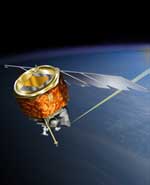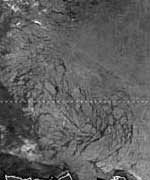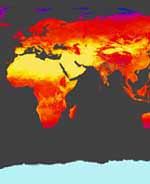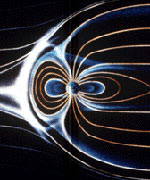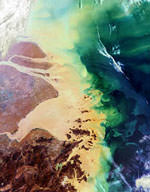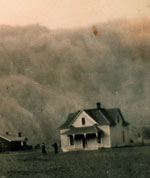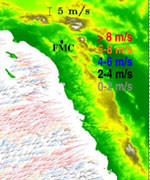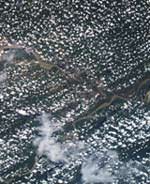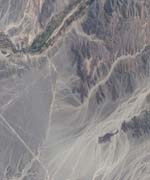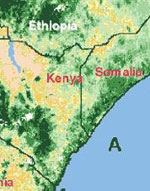
Image credit: NASA
Last year more than a million people died of malaria, mostly in Sub-saharan Africa. Outbreaks of Dengue Fever, hantavirus, West Nile Fever, Rift Valley Fever, and even Plague still occasionally strike villages, towns, and whole regions. To the dozens or hundreds who suffer painful deaths, and to their loved ones, these diseases must seem to spring upon them from nowhere.
Yet these diseases are not without rhyme or reason. When an outbreak occurs, often it is because environmental conditions such as rainfall, temperatures, and vegetation set the stage for a population surge in disease-carrying pests. Mosquitoes or mice or ticks thrive, and the diseases they carry spread rapidly.
So why not watch these environmental factors and warn when conditions are ripe for an outbreak? Scientists have been tantalized by this possibility ever since the idea was first expressed by the Russian epidemiologist E. N. Pavlovsky in the 1960s. Now technology and scientific know-how are catching up with the idea, and a region-wide early warning system for disease outbreaks appears to be within reach.
Ronald Welch of NASA’s Global Hydrology and Climate Center in Huntsville, Alabama, is one of the scientists working to develop such an early warning system. “I have been to malarious areas in both Guatemala and India,” he says. “Usually I am struck by the poverty in these areas, at a level rarely seen in the United States. The people are warm and friendly, and they are appreciative, knowing that we are there to help. It feels very good to know that you are contributing to the relief of sickness and preventing death, especially the children.”
The approach employed by Welch and others combines data from high-tech environmental satellites with old-fashioned, “khaki shorts and dusty boots” fieldwork. Scientists actually seek out and visit places with disease outbreaks. Then they scrutinize satellite images to learn how disease-friendly conditions look from space. The satellites can then watch for those conditions over an entire region, country, or even continent as they silently slide across the sky once a day, every day.
In India, for example, where Welch is doing research, health officials are talking about setting up a satellite-based malaria early warning system for the whole country. In coordination with mathematician Jia Li of the University of Alabama at Huntsville and India’s Malaria Research Center, Welch is hoping to do a pilot study in Mewat, a predominantly rural area of India south of New Delhi. The area is home to more than 700,000 people living in 491 villages and 5 towns, yet is only about two-thirds the size of Rhode Island.
“We expect to be able to give warnings of high disease risk for a given village or area up to a month in advance,” Welch says. “These ‘red flags’ will let health officials focus their vaccination programs, mosquito spraying, and other disease-fighting efforts in the areas that need them most, perhaps preventing an outbreak before it happens.”
Outbreaks are caused by a bewildering variety of factors.
For the mosquito species that carries malaria in Welch’s study area, for example, an outbreak hotspot would have pools of stagnant water where adult mosquitoes can deposit their eggs to mature into new adults. These could be lingering puddles on dense, clay-like soil after heavy rains, swamplands located nearby, or even rain-filled buckets habitually left outside by villagers. A malaria hotspot would be warmer than 18?C, because in colder weather, the single-celled “plasmodium” parasite that actually causes malaria operates too slowly to go through its infection cycle before the host mosquito dies. But the weather mustn’t be too hot, or the mosquitoes would have to hide in the shade. The humidity must hover in the 55% to 75% range that these mosquitoes require for survival. Preferably there would be cattle or other livestock within the mosquitoes’ 1 km flight range, because these pests actually prefer to feed on the blood of animals.
If all of these conditions coincide, watch out!
Documenting some of these factors, such as soil type and local bucket-leaving habits, requires initial groundwork by researchers in the field, Welch notes. This information is plugged into a computerized mapping system called a Geographical Information Systems database (GIS). Fieldwork is also required to characterize how the local species of mosquito behaves. Does it bite people indoors or outdoors or both? Other factors, like the locations of cattle pastures and human dwellings, are inputted into the GIS map based on ultra-high resolution satellite images from commercial satellites like Ikonos and QuickBird, which can spot objects on the ground as small as 80 cm across. Then region-wide variables like temperature, rainfall, vegetation types, and soil moisture are derived from medium-resolution satellite data, such as from Landsat 7 or the MODIS sensor on NASA’s Terra satellite. (MODIS stands for MODerate-resolution Imaging Spectrometer.)
Scientists feed all of this information into a computer simulation that runs on top of a digital map of the landscape. Sophisticated mathematical algorithms chew on all these factors and spit out an estimate of outbreak risk.
The basic soundness of this approach for estimating disease risk has been borne out by previous studies. A group from the University of Nevada and the Desert Research Institute were able to “predict” historical rates of deer-mouse infection by the Sin Nombre virus with up to 80% accuracy, based only on vegetation type and density, elevation and slope of the land, and hydrologic features, all derived from satellite data and GIS maps. A joint NASA Ames / University of California at Davis study achieved a 90% success rate in identifying which rice fields in central California would breed large numbers of mosquitoes and which would breed fewer, based on Landsat data. Another Ames project predicted 79% of the high-mosquito villages in the Chiapas region of Mexico based on landscape features seen in satellite images.
Perfect predictions will likely never be possible. Like weather, the phenomenon of human disease is too complicated. But these encouraging results suggest that reasonably accurate risk estimates can be achieved by combining old-fashioned fieldwork with the newest in satellite technologies.
“All of the necessary pieces of the puzzle are there,” Welch says, offering the hope that soon disease outbreaks that seem to come “from out of nowhere” will catch people off guard much less often.
Original Source: NASA Science Story
